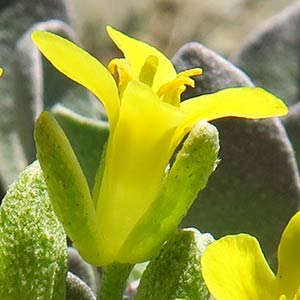|
Gordon's bladderpod
|
alpine twin-pod, Washington bladder-pod, Washington twin-pod
|
| Annuals, biennials, or perennials; (short-lived); with a fine taproot; usually densely pubescent, trichomes (sessile or short-stalked), 4–7-rayed, rays distinct and furcate or bifurcate, (nearly smooth to finely tuberculate). |
Perennials; caudex usually simple, rarely branched, (cespitose); (silvery) pubescent throughout, trichomes several-rayed, rays (1- or) 2-bifurcate, (low-umbonate, tubercles relatively few, small). |
several from base, erect to decumbent or prostrate, (unbranched or branched, sometimes densely leaved), 1–3.5(–4.5) dm. |
several from base, decumbent to ascending, (unbranched), 0.5–1.5 dm. |
blade obovate to broadly oblong, 1.5–5(–8) cm, margins lyrate-pinnatifid, dentate, or entire. |
(petiole slender); blade obovate, 3–5 cm (width 10–20 mm, base tapering abruptly to petiole), margins entire, (apex rarely slightly acute). |
(proximal sometimes petiolate, distal sessile); blade linear to oblanceolate, often falcate, 1–4(–7) cm, (proximal with base sometimes cuneate), margins entire, repand, or shallowly dentate. |
blade oblanceolate, 0.5–1.5 cm (width 3–5 mm), margins entire. |
dense. |
subcorymbose. |
sepals elliptic or oblong, 3–6.5 mm, (lateral pair subsaccate, median pair thickened apically, cucullate); petals (widely spreading at anthesis, yellow to orange, claw sometimes whitish), cuneate, obdeltate, or obovate, (tapering to claw), 5–8(–10) mm, (claw often widened at base). |
sepals oblong, 8–10 mm; petals spatulate, 12–14 mm. |
(divaricate-ascending, sigmoid or, sometimes, nearly straight), 5–15(–25) mm. |
(divaricate, straight), 5–10 mm. |
(shortly stipitate), subglobose, not or slightly compressed, (3–)4–8 mm; valves (not retaining seeds after dehiscence), glabrous throughout; replum as wide as or wider than fruit; ovules (8–)12–20(–26) per ovary; style (1.5–)2–4(–5) mm. |
didymous, mostly highly inflated (strongly flattened at least in 1/2 toward replum), 14–18 × 14–18 mm, (papery, basal sinus slightly notched, apical open, shallow); valves (retaining seeds after dehiscence), evenly pubescent; replum lanceolate, 7–10 mm, width 1.5–2.5 mm, as wide as or wider than fruit, apex acute to acuminate; ovules 8–10 per ovary; style 5–7 mm. |
flattened. |
flattened, (2–3 mm). |
= 12, 32. |
= 48–52, 52, 64, 67–70. |
|
|
|
|
| Flowering Feb–Jul. |
Flowering May–Jun. |
| Sandy or light soils, rocky plains, caprock ledges, gravelly brushland, sandy desert washes, stream bottoms, pastures, roadsides, abandoned fields |
Alpine scree, rocky ridges, talus slopes, volcanic sands and gravel, serpentine gravel, granitic slopes, mountain shrub, subalpine fir, and whitebark pine communities |
| 150-1700 m (500-5600 ft) |
(700-)1300-2400 m ((2300-)4300-7900 ft) |
|
AZ; KS; NM; OK; TX; VA; Mexico (Chihuahua, Sonora)
|
WA
|
Physaria gordonii was reported from Virginia in 1987 by Robert Wright from a Hampton Shale roadcut along the Blue Ridge Parkway, where it was probably a short-lived waif. Subspecies densifolia, of Lincoln County, New Mexico, of which there is now more material than Rollins had available in 1993, appears to represent a suite of environmentally determined, variable, and intergrading characteristics that does not merit taxonomic recognition. (Discussion copyrighted by Flora of North America; reprinted with permission.) |
|
| FNA vol. 7, p. 640. |
FNA vol. 7, p. 624. |
| Brassicaceae > tribe Physarieae > Physaria |
Brassicaceae > tribe Physarieae > Physaria |
P. acutifolia, P. alpestris, P. alpina, P. angustifolia, P. arctica, P. arenosa, P. argyraea, P. arizonica, P. aurea, P. bellii, P. brassicoides, P. calcicola, P. calderi, P. carinata, P. chambersii, P. cinerea, P. condensata, P. congesta, P. cordiformis, P. curvipes, P. densiflora, P. didymocarpa, P. dornii, P. douglasii, P. eburniflora, P. engelmannii, P. eriocarpa, P. fendleri, P. filiformis, P. floribunda, P. fremontii, P. garrettii, P. geyeri, P. globosa, P. gooddingii, P. gracilis, P. grahamii, P. hemiphysaria, P. hitchcockii, P. humilis, P. integrifolia, P. intermedia, P. kingii, P. klausii, P. lata, P. lepidota, P. lesicii, P. lindheimeri, P. ludoviciana, P. macrocarpa, P. mcvaughiana, P. montana, P. multiceps, P. navajoensis, P. nelsonii, P. newberryi, P. obcordata, P. obdeltata, P. occidentalis, P. oregona, P. ovalifolia, P. pachyphylla, P. pallida, P. parviflora, P. parvula, P. pendula, P. pinetorum, P. prostrata, P. pruinosa, P. pulvinata, P. purpurea, P. pycnantha, P. rectipes, P. recurvata, P. reediana, P. rollinsii, P. saximontana, P. scrotiformis, P. sessilis, P. spatulata, P. subumbellata, P. tenella, P. thamnophila, P. tumulosa, P. valida, P. vicina, P. vitulifera |
P. acutifolia, P. alpina, P. angustifolia, P. arctica, P. arenosa, P. argyraea, P. arizonica, P. aurea, P. bellii, P. brassicoides, P. calcicola, P. calderi, P. carinata, P. chambersii, P. cinerea, P. condensata, P. congesta, P. cordiformis, P. curvipes, P. densiflora, P. didymocarpa, P. dornii, P. douglasii, P. eburniflora, P. engelmannii, P. eriocarpa, P. fendleri, P. filiformis, P. floribunda, P. fremontii, P. garrettii, P. geyeri, P. globosa, P. gooddingii, P. gordonii, P. gracilis, P. grahamii, P. hemiphysaria, P. hitchcockii, P. humilis, P. integrifolia, P. intermedia, P. kingii, P. klausii, P. lata, P. lepidota, P. lesicii, P. lindheimeri, P. ludoviciana, P. macrocarpa, P. mcvaughiana, P. montana, P. multiceps, P. navajoensis, P. nelsonii, P. newberryi, P. obcordata, P. obdeltata, P. occidentalis, P. oregona, P. ovalifolia, P. pachyphylla, P. pallida, P. parviflora, P. parvula, P. pendula, P. pinetorum, P. prostrata, P. pruinosa, P. pulvinata, P. purpurea, P. pycnantha, P. rectipes, P. recurvata, P. reediana, P. rollinsii, P. saximontana, P. scrotiformis, P. sessilis, P. spatulata, P. subumbellata, P. tenella, P. thamnophila, P. tumulosa, P. valida, P. vicina, P. vitulifera |
| Vesicaria gordonii, Alyssum gordonii, Lesquerella gordonii, Lesquerella gordonii var. densifolia, P. gordonii subsp. densifolia, P. gordonii var. densifolia |
Lesquerella alpestris |
| (A. Gray) O’Kane & Al-Shehbaz: Novon 12: 323. (2002) |
Suksdorf: W. Amer. Sci. 15: 58. (1906) |
| |


